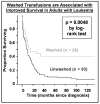The platelet as an immune cell-CD40 ligand and transfusion immunomodulation
- PMID: 19184537
- PMCID: PMC2891252
- DOI: 10.1007/s12026-009-8106-9
The platelet as an immune cell-CD40 ligand and transfusion immunomodulation
Abstract
The discovery that platelets possess cell membrane, cytoplasmic, and secreted forms of the co-stimulatory molecule CD40 ligand (CD40L, also known as CD154) has led to a revolution in the view of this anucleate, differentiated cell fragment, previously thought only to be involved in blood clotting (hemostasis). During the last decade, it has become clear that platelets function in innate and adaptive immunity and possess pro-inflammatory, as well as pro-thrombotic properties. They interact not only with other platelets and endothelial cells, but also with lymphocytes, dendritic cells, and structural cells such as fibroblasts. Soluble forms of CD40L (sCD40L) in the human circulation are almost entirely derived from platelets. Elevated levels of CD40L are associated with clinically important conditions, such as vascular disease, abnormal clotting (thrombosis), lung injury, and autoimmune disease. Each year millions of platelet transfusions are given to patients that contain large amounts of sCD40L. sCD40L in the supernatant of stored platelets can induce cytokines, chemokines, and lipid mediators by activating CD40 bearing cells. Increased levels of sCD40L in transfused blood are associated with transfusion-related acute lung injury, a potentially fatal complication, as well as more common, milder transfusion reactions such as fever and rigors. These effects come under the rubric of transfusion immunomodulation, which postulates that transfusion recipient biology, particularly immune function, is dramatically altered by transfusion of stored allogeneic blood.
Figures

Platelets become activated at the site of vessel injury
Activated platelets express / secrete CD40L
Platelet CD40L serves to trigger the onset of inflammation




Similar articles
-
The signaling role of CD40 ligand in platelet biology and in platelet component transfusion.Int J Mol Sci. 2014 Dec 3;15(12):22342-64. doi: 10.3390/ijms151222342. Int J Mol Sci. 2014. PMID: 25479079 Free PMC article. Review.
-
CD40 ligand (CD154) involvement in platelet transfusion reactions.Transfus Clin Biol. 2012 Jun;19(3):98-103. doi: 10.1016/j.tracli.2012.02.003. Epub 2012 Jun 14. Transfus Clin Biol. 2012. PMID: 22703674 Free PMC article. Review.
-
Lack of evidence of CD40 ligand involvement in transfusion-related acute lung injury.Clin Exp Immunol. 2011 Aug;165(2):278-84. doi: 10.1111/j.1365-2249.2011.04422.x. Epub 2011 May 23. Clin Exp Immunol. 2011. PMID: 21605114 Free PMC article.
-
Platelets as Key Factors in Inflammation: Focus on CD40L/CD40.Front Immunol. 2022 Feb 3;13:825892. doi: 10.3389/fimmu.2022.825892. eCollection 2022. Front Immunol. 2022. PMID: 35185916 Free PMC article. Review.
-
Platelet transfusions: impact on hemostasis, thrombosis, inflammation and clinical outcomes.Thromb Res. 2011 Apr;127(4):287-91. doi: 10.1016/j.thromres.2010.10.012. Epub 2010 Nov 19. Thromb Res. 2011. PMID: 21093892 Free PMC article. Review.
Cited by
-
A High Level of Soluble CD40L Is Associated with P. aeruginosa Infection in Patients with Cystic Fibrosis.PLoS One. 2016 Dec 28;11(12):e0168819. doi: 10.1371/journal.pone.0168819. eCollection 2016. PLoS One. 2016. PMID: 28030642 Free PMC article.
-
Characterization of Platelet Biologic Markers in the Early Pathogenesis of Postoperative Acute Respiratory Distress Syndrome.Crit Care Explor. 2022 Jul 15;4(7):e0728. doi: 10.1097/CCE.0000000000000728. eCollection 2022 Jul. Crit Care Explor. 2022. PMID: 36818750 Free PMC article.
-
The Non-Hemostatic Aspects of Transfused Platelets.Front Med (Lausanne). 2018 Feb 27;5:42. doi: 10.3389/fmed.2018.00042. eCollection 2018. Front Med (Lausanne). 2018. PMID: 29536007 Free PMC article. Review.
-
Interactions with and activation of immune cells by CD41a+ extracellular vesicles.Front Immunol. 2025 Feb 14;16:1509078. doi: 10.3389/fimmu.2025.1509078. eCollection 2025. Front Immunol. 2025. PMID: 40028321 Free PMC article.
-
Soluble CD40 ligand, a mediator of sepsis or of transfusion-related adverse effects?Crit Care. 2011;15(3):429; author reply 429. doi: 10.1186/cc10237. Epub 2011 May 31. Crit Care. 2011. PMID: 21639957 Free PMC article. No abstract available.
References
-
- Henn V, Slupsky JR, Grafe M, Anagnostopoulos I, Forster R, Muller-Berghaus G, Kroczek RA. CD40 ligand on activated platelets triggers an inflammatory reaction of endothelial cells. Nature. 1998;391:591–4. - PubMed
-
- Banchereau J, Briere F, Caux C, Davoust J, Lebecque S, Liu YJ, Pulendran B, Palucka K. Immunobiology of dendritic cells. Annu Rev Immunol. 2000;18:767–811. - PubMed
-
- Kehry MR. CD40-mediated signaling in B cells. Balancing cell survival, growth, and death. J Immunol. 1996;156:2345–8. - PubMed
-
- Graca L, Honey K, Adams E, Cobbold SP, Waldmann H. Cutting edge: anti-CD154 therapeutic antibodies induce infectious transplantation tolerance. J Immunol. 2000;165:4783–6. - PubMed
Publication types
MeSH terms
Substances
Grants and funding
LinkOut - more resources
Full Text Sources
Research Materials

